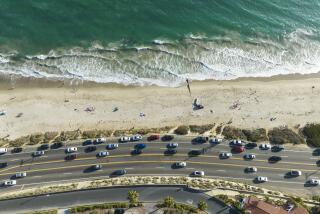Sewage May Force O.C. Beach Closure
- Share via
Orange County’s public health officer Tuesday said he is considering closing a stretch of Huntington Beach’s shoreline this summer because of concerns that treated sewage released 4 miles offshore is drifting back toward the beach.
The Orange County Sanitation District on Tuesday also unveiled a $4.1-million study to determine whether a similar sewage plume caused Huntington Beach’s devastating shoreline closures in the summer of 1999.
For the record:
12:00 a.m. May 10, 2001 FOR THE RECORD
Los Angeles Times Thursday May 10, 2001 Home Edition Part A Part A Page 2 A2 Desk 1 inches; 29 words Type of Material: Correction
Beach closures--The headline on an article Wednesday about ocean pollution in Huntington Beach incorrectly described the length of shoreline that faces closures this summer. It is unspecified at this time.
If true, the district could be forced to spend $30 million to $400 million to reduce bacteria levels in the waste water it pipes offshore, said Lisa Lawson, spokeswoman for the sanitation district.
Public Health Officer Mark Horton said he may make a “semi-permanent” decision to close the beach or possibly post health warnings to alert swimmers. Another option would be to keep the status quo--to make decisions based on regular water quality sampling results.
“It boils down to what do we feel we need to do to maximize protection of public health,” Horton said. “We’re considering the options.”
Horton said the $4.1 million being spent to determine whether the sewage plume is responsible for the contamination shows how seriously the theory is being taken.
Horton said a closure or posting would affect only a fraction of the city’s shoreline, but the stakes still are enormous. In 1999, two months of beach closures wreaked havoc on the coastal economy and tarnished Surf City’s reputation. Huntington Beach’s 8.5-mile shoreline attracts 10 million visitors a year.
“They need to follow the law and they need to do their job,” said Huntington Beach city spokesman Rich Barnard. “I’m surely not one to tell them how to do their job.”
But “if they’re going to take those kinds of drastic actions, they need to be based on some data--either scientific data or testing data . . . not just to arbitrarily make some decision that’s not based” on facts, he said.
Horton said he doesn’t know when the decision will be made, but that it will happen “before the swim season gets too far along.”
He also said the decision may change based on future study results.
Under state law, health officials must close beaches if they know sewage is present. If bacteria levels are high because of urban runoff, signs are generally posted warning swimmers about potential risks.
Tracking Down Pollution Source
However, if health officials only suspect that sewage is present, they are given discretion to decide how to respond.
In the summer of 1999, a mile of shoreline was closed in Huntington Beach in July after extremely high bacteria readings--which health officials suspected were caused by raw human sewage hitting the beach.
By late August, a stretch of more than 4 miles of ocean from Goldenwest Street to the Santa Ana River mouth was off-limits because of the contamination.
The Health Care Agency drew kudos from environmentalists for not caving to pressure from local politicians to reopen the beach.
When leaking sewer lines were later ruled out, authorities and researchers suspected that the culprit was urban runoff flowing from Talbert Marsh and the Santa Ana River.
In November, UC Irvine scientist Stanley Grant offered a stunning new theory: the Orange County Sanitation District’s treated sewage plume released 4 miles offshore is being brought back to the surf zone by a combination of tides, underwater waves and a local power plant’s ocean-fed cooling system.
The sanitation district and others will test Grant’s hypothesis during one 24-hour scientific survey in May and five 48-hour surveys from June to September.
Talbert Marsh and Santa Ana River researchers may also conduct a dye study to track how runoff disperses upon entering the ocean.
AES Corp., whose power plant’s outfall may be contributing to the problem, has pledged to contribute $350,000 for the expenses. It may be forced to pay $1 million if a plan to refire two generators to help ease the energy crunch is approved.
(BEGIN TEXT OF INFOBOX / INFOGRAPHIC)
Beach Pollution Theories
A $4.1-million water quality study off Huntington Beach will try to determine the cause of high bacteria levels that closed the shoreline in summer 1999. Scientists theorize that high tides and/or underwater waves cause sewage from a sanitation plant outfall to flow ashore.
*
Reporting by BRADY MacDONALD / Los Angeles Times
More to Read
Sign up for Essential California
The most important California stories and recommendations in your inbox every morning.
You may occasionally receive promotional content from the Los Angeles Times.











